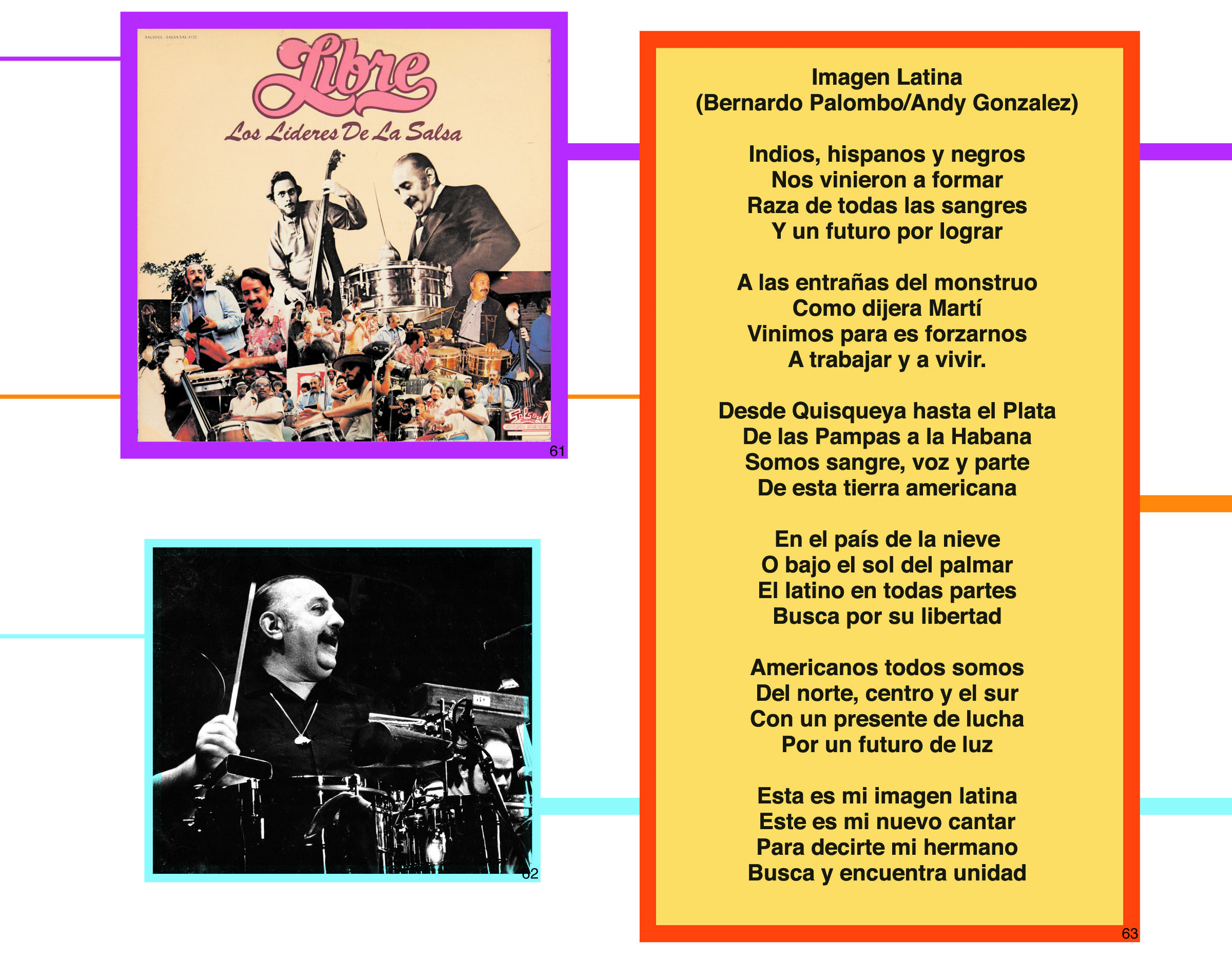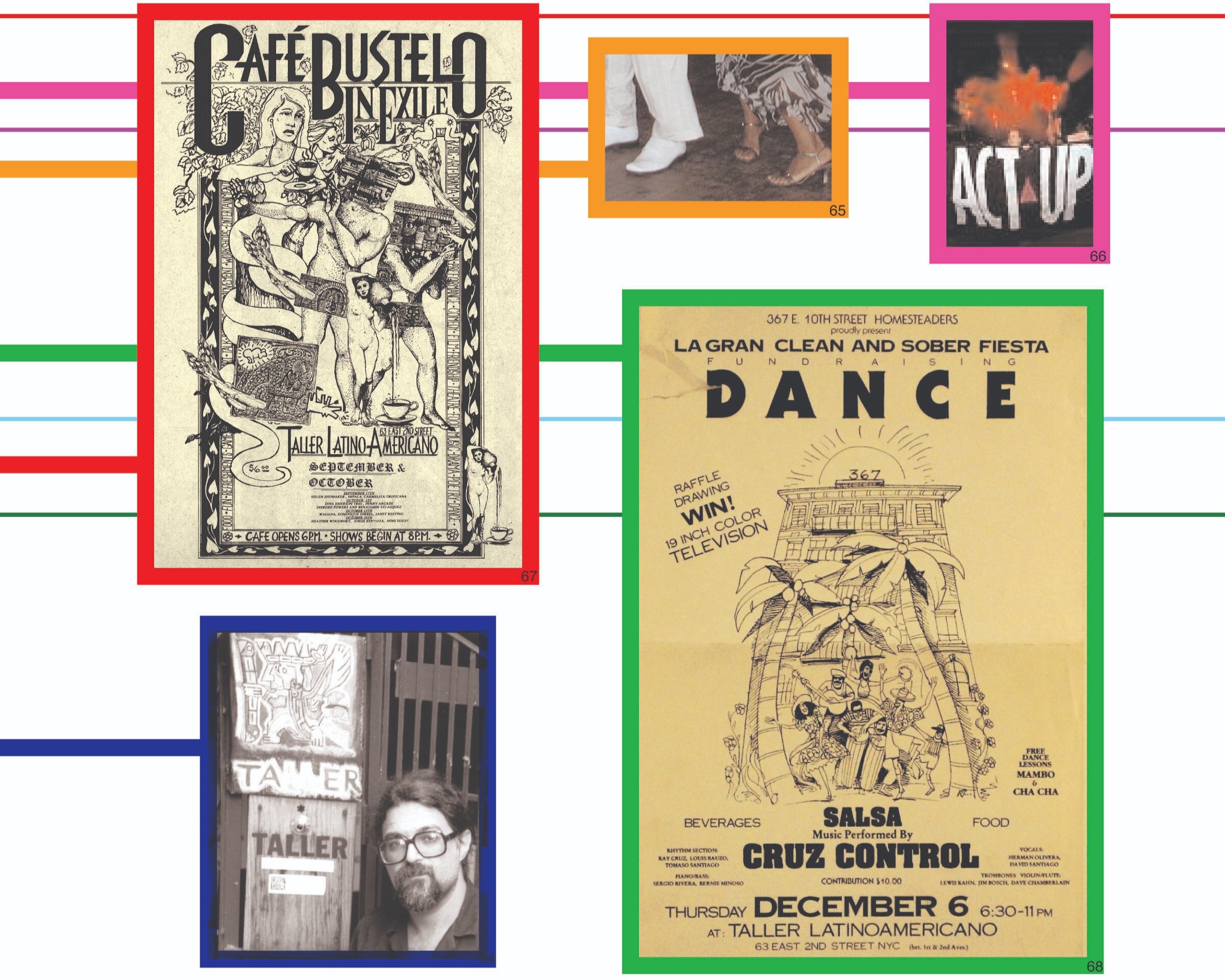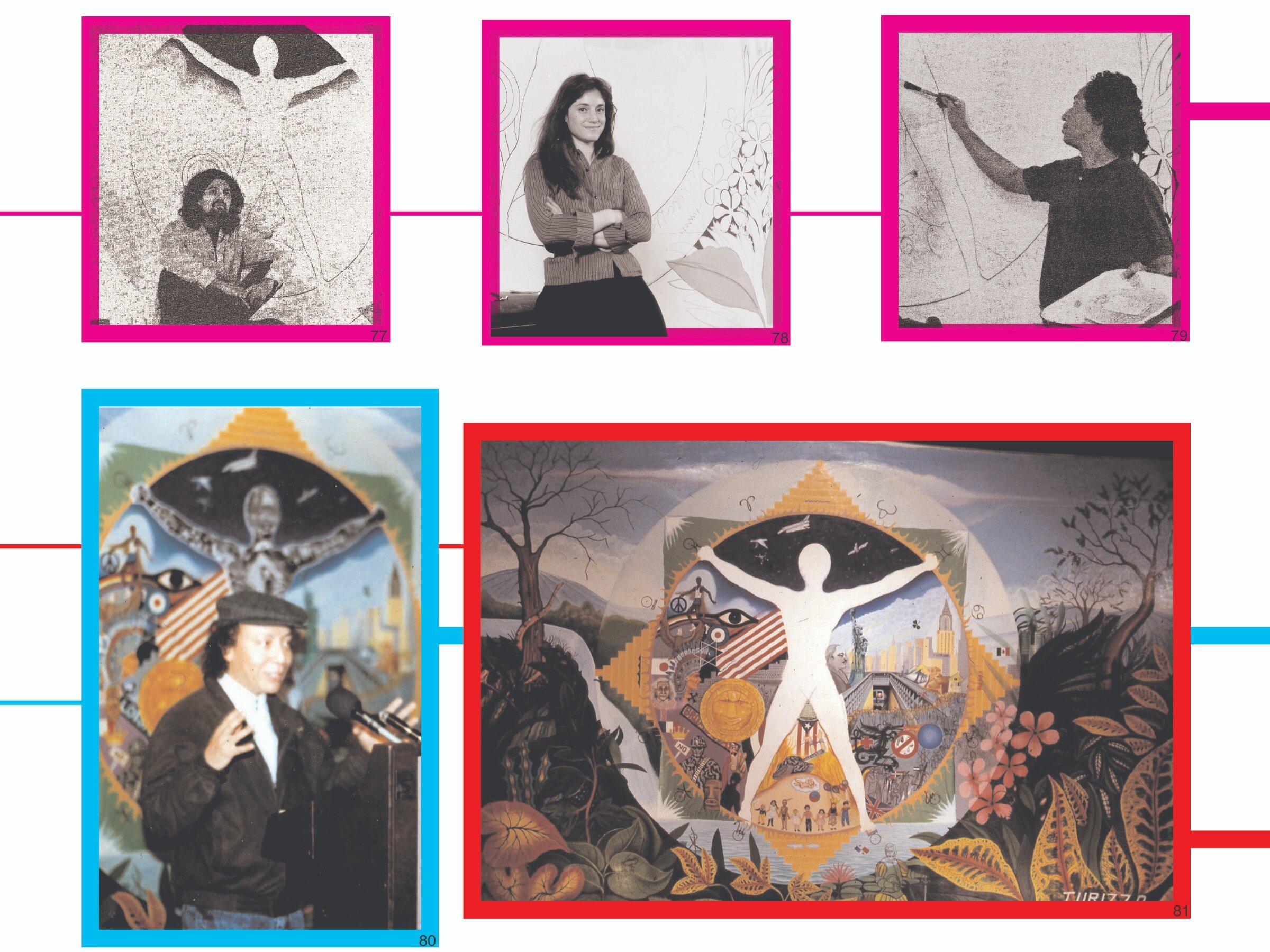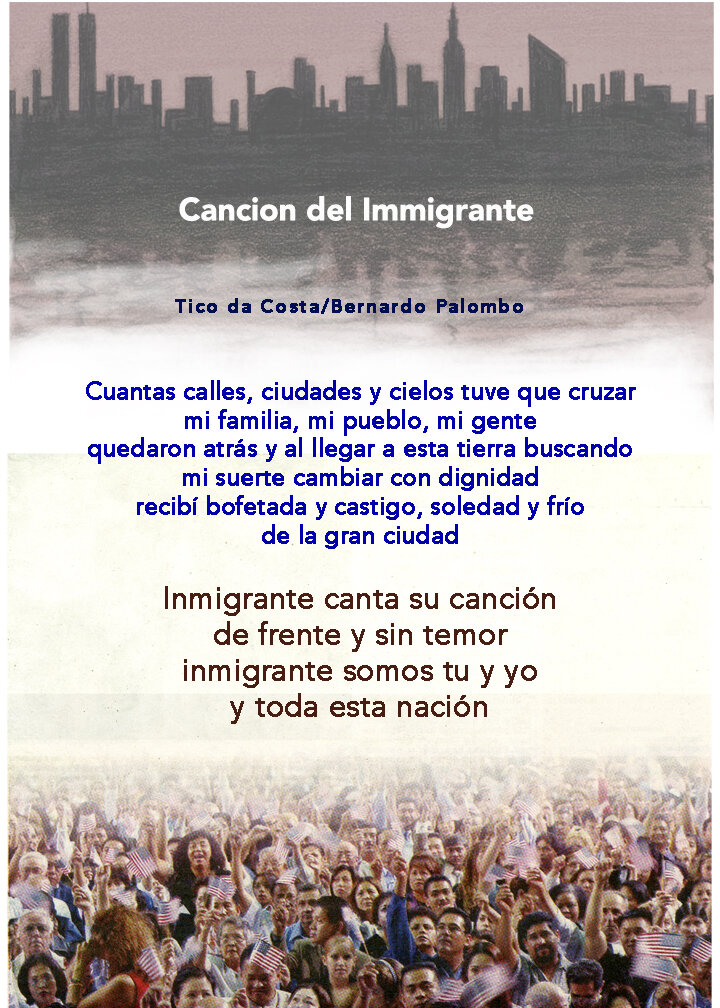Los Archivos del Taller: A New York Story
Salvador Allende Poster, El Salvador Libre, Night for Argentina poster art by Nikol Drouin
Corría el año 1979 y a Nueva York llegaban nuevos grupos de inmigrantes. Primero fue el Sur. Pinochet en Chile y Videla en Argentina despoblaron el país . La situación en América Central hizo que Nueva York se llenara de nicaragüenses y salvadoreños que agregaron un toque continental al predominante caribe latinoamericano de la ciudad.
It was 1979 and new groups of immigrants were arriving in New York. First there was the South. Pinochet in Chile and Videla in Argentina were emptying the country. The situation in Central America caused New York to fill with Nicaraguans and Salvadorians who added a continental touch to the city's predominantly Caribbean culture.
pupuseria: Salvadorean eatery
"Tango in the Sky": Oscar Pardo; Salsa - photo: Deborah Harse
La salsa es el punto de unión de casi todos los grupos, pero en Jackson Heights también hay tango y cumbia y en Long Island hay tardeadas mexicanas y música típica en las pupuserías salvadoreñas.
Salsa was the meeting point for nearly all of the groups, though in Jackson Heights there was tango and cumbia, and in Long Island Mexican “tardeadas” and typical music in Salvadorian pupuserías.
Chile-New York ceramics installation by Jeff Schlanger;
"Alto a la guerra" poster for Central America circa 1980;
"Moderatley Repressive" poster quoting Ann Kirkpatrick about the dictatorial governments of Latin America
Pero no todo es baile. Mucha gente de esa que emigra han dejado atrás, cárcel tortura y angustias económicas. Las condiciones del emigrante son duras. Lo primero que se pierde es lo que más se añora: la cultura.
But dance is not everything, and many of those who immigrated had left prison, torture and financial anguishes behind. The conditions for immigrants are hard. The first thing that is lost is the thing that is missed the most: culture.
photo- Dominican Campesino;
"Labrador" painting by Alberto Gamino; photo - Chilean laborers by Alejandro Stuart
Cultura viene de cultivo. La cultura de los pueblos se expresa en su forma de cultivar la tierra, de cultivar el buen trato en la comunidad, y en la forma de cultivar una relación con lo sagrado o lo transcendente.
Culture comes from cultivation. Rural culture is expressed in the form of cultivating the land, cultivating good treatment of the community, and in the form of cultivating a relationship with the sacred or the transcendental.
Photographs by Ric Pliego; “Manhattan” - Illustration: Demian Palombo
En Nueva York, no se puede cultivar la tierra. Pisamos siempre el cemento, es muy dificil crear comunidad, y hay demasiados rascacielos y contaminación para notar lo sagrado. Para cultivar algo se necesita un terreno, un espacio y ante la necesidad de crear un lugar de encuentro para todas esas culturas que llegaban a Nueva York...
In New York, the land cannot be cultivated, the floor is always of concrete, it is very difficult to create a community, and there are too many skyscrapers and too much contamination to note the sacred. In order to cultivate something you need some land, a space, and in view of the necessity to create a meeting place for all these cultures that were arriving in New York...
El Taller logo 1979; Bernardo Palombo;
Maren Cristina Palombo-Moses and Emmanuel;
Founders: (from left to right) Paul Wasserman, Judith Rabinovich, Tony Maples, Fernando Persico
A un grupo de gente latinoamericana y también norteamericana, se les ocurrió abrir El Taller. El nombre lo sugirió el cineasta chileno puertoriqueño Diego Echeverría. Le agregamos latinoamericano para incluir a todos.
It occurred to us, a group of Latin Americans and also North Americans, to open El Taller. Diego Echeverría, a Chilean-Puerto Rican filmmaker, gave us the name.
Antonio Caban Vale "El Topo";
lyrics: “Verde Luz”: Antonio Caban Vale "El Topo";
Flyer: "EL Topo" @ El Taller 1979 art by Palombo
En marzo del 1979, Antonio Cabán Vale (“El Topo”) inaguró El Taller con un concierto que terminó al otro día. Su primer disco, el de “Verde Luz” con el sonido de las olas, se vendió como pan caliente.
In March 1979, Antonio Cabán Vale (“El Topo”) opened El Taller with a concert that ended on another day. His first album, featuring Verde Luz, the one with the sound of waves, sold like hot cakes.
Anthology cover - Victor Jara and children;
El Taller flyer circa 1980;
Homero Manzi cancionero cover; "Sur": Homero Manzi
Familias de refugiados chilenos empezaron “La escuelita chilena” para que sus hijos no olvidaran la historia del país donde nacieron. Alberto Adelach llenó la ciudad de bandoneones y “lunas suburbanas” contando la historia del tango.
Families of Chilean refugees started the “Escuelita chilena” so that their children would not forget the history of the country in which they were born. Alberto Adelach filled the city with accordions and “lunas suburbanas”, recounting the history of tango.
Mercedes Sosa @ El Taller 1982 Photo: Uberto Sagramoso;
Pete Seeger; Mercedes Sosa - Illustration: Isabel Torres;
Pete Seeger at El Taller dedicating the Guthrie/Parra Auditorium - Photo: Mel Rosenthal
Mercedes Sosa cantó en un teatro que rebalsaba gente y en donde el crítico del New York Times, Jon Pareles, tuvo que buscarse una silla porque no quedaban más butacas libres en la sección de Prensa. Mas tarde, Mercedes y Pete Seeger inauguraron el auditorio del Taller con los nombres de Violeta Parra y Woody Guthrie.
Mercedes Sosa sang to a theatre overflowing with people and in which the New York Times critic, Jon Pareles, had to find himself a chair because there were no more free seats in the press section. Later, Mercedes and Pete Seeger inaugurated El Taller's “Violeta Parra and Woodie Guthrie” auditorium.
Gallery;
Palombo teaches students 1979;
Flyer: Ernesto Cardenal @ El Taller drawing by Palombo
Mientras tanto El Taller pagaba la renta dando clases de español a una audiencia que venía no solo a estudiar español sino también a participar en un ambiente cultural donde músicos, artistas y gente de todas las Américas presentaba su trabajo.
Vino Ernesto Cardenal y habló sobre Nicaragua y leyó poemas suyos y ajenos, al final ayudó a servir el vigorón y toda la comida que muchos voluntarios prepararon.
During all of this, El Taller paid its rent by offering Spanish classes to an audience who came not only to study Spanish, but also to participate in a cultural environment where musicians, artists and people from all over the Americas presented their work.
Ernesto Cardenal came to speak about Nicaragua and read his own and others' poems, and in the end helped to serve el vigorón and all the food that the many volunteers had prepared.
Paintings: Alfredo Ceibal, Silvio De la Cruz, Turizzo, Vatenor
Pintores y poetas usaron El Taller para mostrar su trabajo por primera vez en Nueva York. Turizzo, Alfredo Ceibal, Silvio de la Cruz fueron los primeros en engalanar la galería. Al pintor brasilero Vatenor lo arrestaron oficiales de Inmigración la misma noche de la apertura de su exhibición. No tenía “green card”.
Painters and poets used El Taller to exhibit their work for the first time in New York. Turizzo, Alfredo Ceibal and Silvio de la Cruz were the first to grace the gallery. The Brazilian painter Vatenor was arrested by immigration officials the same night that his exhibition opened. He didn't have a “green card”.
Poets: Pedro Pietri, Grace Paley, Sandra María Esteves, Tato Laviera, Allen Ginsberg
En español, en inglés, y en “spanglish”, Pedro Pietri, Sandra María Esteves, Papoleto Meléndez,Ivan Silén y Tato Laviera cimentaban el puente poético “Puerto Rico–Nueva York” y compartían micrófono con Grace Paley, Allen Ginsberg, Roberto Fernandez Iglesias y muchos otros.
In Spanish, in English and in “Spanglish”, Pedro Pietri, Sandra María Esteves, Papoleto Meléndez, Iván Silén and Tato Laviera lay the foundations of the poetic bridge “Puerto Rico-New York” and shared the microphone with Grace Paley, Allen Ginsberg, Roberto Fernández Iglesias, and many others.
Juilo Cortazar's "Noticias para Viajeros",
Julio Cortazar, Latin American Literature @ El Taller Flyer 1979
Julio Cortázar explicó como, sin él ser poeta, Nicaragua lo había hecho poeta. Leyó un poema “Guia de viajeros” y lo dejó escrito en una servilleta. Se la dio a Palombo diciendole que le parecía que era mejor para cantar que para leer.
Julio Cortázar explained how, without him being a poet, Nicaragua had made him a poet. He read a poem, “Guía de Viajeros”, and left it written on a napkin, saying that he thought it was better for singing than for reading.
El Taller flyer 1982;
El Salvador:Another Vietnam; Americas in Transition
Palombo le puso música y la usamos en la película “Americas in Transition”, un documental que muestra las invasiones militares estadounidenses en América Latina y que fué nominada para un Oscar como mejor documental en el año 1982. “El Salvador, Another Vietnam”, fue tambien selección.
Palombo put it to music and used it in the soundtrack to the film “Americas En Transicíón”, a documentary charting the American military invasions of Latin America, which with another El Taller colaboration, “El Salvador, Another Vietnam”, was nominated for an Oscar for best documentary in 1982.
Para ese tiempo cientos de músicos usaban el Taller como base de operaciones. Luis Díaz presentó “Santo Domingo es un merengue triste” y el “Canto a los misterios”.
By this time, hundreds of musicians were using El Taller as a base of operations. Luís Díaz performed two seminal concerts: “Santo Domingo es un merengue triste” and “Canto a los misterios”.
Grupo Aymara de Bolivia se presentaba periódicamente y también grupos de músicos norteamericanos tocaban en el Taller , “The Dead Kennedys”, “The Beasty Boys” y otros grupos de rock y música alternativa eran parte del programa habitual.
The group Aymara of Bolivia periodically made appearances and North American musicians also played at El Taller. The Dead Kennedys, The Beastie Boys, and other rock and alternative music groups were regular performers.
Presentamos por primera vez al maestro Atahualpa Yupanqui en el Carnegie Hall.
We brought Atahualpa Yupanqui to perform in Carnegie Hall- his only performance ever in New York.
En 1984, el Taller concretó uno de sus projectos más ambiciosos. Produjo la “Misa Campesina Nicaraguense”de Carlos Mejía Godoy en la catedral de San Juan el Divino. Durante dos años más de 300 personas trabajaron preparando música , baile, escenografía en un projecto de creatividad por la paz en Centroamérica.
In 1984, El Taller completed one of its most ambitious projects. It produced the “Misa Campesina Nicaragüense” by Carlos Mejía Godoy at the Cathedral of St. John the Divine. It took us over two years with the help of more than three hundred people to prepare the music, choreography and set design for this “offering” of creativity for peace in the Americas.
El “Conjunto Libre” de Manny Oquendo clausuró el Taller de la calle 21 con un baile del día de San Valentín. El camión de la mudanza esperaba abajo. Los últimos en irse ayudaron a cargar todo para que el Taller se fuera “con la música a otra parte”.
Manny Oquendo's "Conjunto Libre" closed El Taller on 21st Street with a Valentine's Day dance. The moving van waited below. The last people leaving helped to load everything up so that El Taller could go “someplace else with the music”.
El tercer Taller fue en Loisaida. Se usó el espacio como un centro comunal. Había conciertos y también bodas. Exibiciones de arte, reuniones de ACT UP, noches de jazz y poesía.
Manny “Suavecito” Maldonado junto con Ray Cruz comenzaron las noches de “Clean and sober Salsa”. Antes de la orquesta la gente venía y aprendía los pasos básicos de la rumba y del guaguancó. Despues Cruz Control tocaba. “La cultura cura” y esas noches de celebración cultural, sin alcohol ni aditivos, la comunidad se embriagaba de ritmo y salud.
The third El Taller was in Loisaida. The space was used as a communal center. There were concerts and weddings too; art exhibitions, ACT UP meetings, jazz nights and poetry.
Manny “Suavecito” Maldonado together with Ray Cruz started “Clean and Sober” salsa nights. Before the band played, people would come and learn the basic steps of the rumba and the guagancó. Afterwards, Cruz Control would play. “Culture Cures” and on these nights of cultural celebration, without drugs or alcohol, the community would get intoxicated from the rhythm.
Philip Glass,
Machu Picchu by Oscar Pardo,
Powaqaatsi Poster,
Flyer for Pete Seeger with Leon Gieco @ El Taller 1996
En el año 87 trabajamos en una pélicula producida por Francis Ford Coppola, Bernardo Palombo acompañó al músico minimalista Philip Glass, como guía y consultor musical en un viaje por Perú, Bolivia y Brasil y al final del viaje compusieron la canción tema de la pélicula “Powaqqatsi”. El coro juvenil hispano de Brooklin la grabó.
In 1987 we worked on a movie produced by Francis Ford Coppola. Palombo accompanied the minimalist musician Philip Glass as a guide and musical consultant on a trip through Peru, Bolivia and Brazil and at the end of the journey composed the theme song of the film “Powaqqatsi”. The Hispanic youth choir of Brooklyn recorded it.
El músico argentino Leon Gieco y Pete Seeger hicieron un concierto para recaudar fondos para el Taller, a ultimo momento se sumó David Byrn
The Argentinean musician León Gieco and Pete Seeger decided to hold a concert to raise funds for El Taller. At the last moment, David Byrne, Founder of the musical group the Talking Heads, joined them on stage.
David Byrne, Susana Baca, Luaka Bop's Peru Negro CD art, Maria Lando Lyric
En ese tiempo David Byrne fundador del grupo “Talking Heads” estaba estudiando español en el Taller. Sus tareas incluían aprender canciones latinoamericanas . Palombo le enseñó un video de Susana Baca cantando María Landó. Byrne la grabó junto con una selección de música afroperuana. Cuando Seeger y Gieco hicieron su concierto Byrne vino a cantar sus “deberes”, cantó “Solo le pido a Dios” y “Carito” con Gieco y terminó cantando con todos la “Guantanamera”.
David Byrne began studying Spanish at El Taller at this time. His homework included learning Latin American songs. Palombo showed him Susana Baca singing Maria Landó, the beautiful Peruvian song by Chabuca Granda, and he recorded it together with a selection of Afro-Peruvian music. When Gieco and Seeger held their concert, Byrne came to sing his dues; he sang “Solo le pido a Dios”, and “Carito” with Gieco, and finished by singing “Guantanamera” with everybody.
María Lando (Chabuca Granda/Cesar Calvo) performed by Susana Baca
Palombo, Donna Light, Turizzo, MTA's 2nd Avenue Subway Mural
Eso pasó a fines de los 90. A principios de 1991 el Taller inauguró “Loisaida continente de siete colores”, un mural con música en la estación de la segunda avenida en el tren “F”. Lo diseñaron Donna Light y Palombo; lo pintó el maestro Turizzo y un grupo de ayudantes. El mural ahora se encuentra en calidad de préstamo en la entrada de Hostos Community College en el Bronx.
This happened at the end of the 90s. At the beginning of 1991 El Taller unveiled an interactive mural with music in the F line Second Avenue subway station. Donna Light and Palombo designed it, the maestro Turizzo painted it with a group of helpers. The mural is currently installed at the entrance to Hostos Communtiy College in the Bronx.
Haitian born Grady Alexis - his works including "Birth of the Sun" - bottom
Estamos llegando en punto donde la historia se ensombrece. Donde el odio, que tambien vive en la ciudad , aparece y mata. El mayo de 1991, la muerte de Grady Alexis un pintor haitiano que vivia con nosotros en el Taller terminó nuestra estadía en Loisaida. Grady tenía su estudio y sus pinturas allí. Un policía vestido de civil lo golpeó en la cabeza y lo tiró al piso. Al poco rato Grady murió. Lo vió mucha gente.
We are reaching a point where the story gets dark. Where hate, which also lives in the city, appears and kills. Grady Alexis was murdered in 1991. Grady, a Haitian painter, had been living with us at El Taller for many years. He had his workshop and his paintings there. An off-duty police officer hit him in the head and knocked him to the ground. Shortly after, Grady died. Many people witnessed it
Illustrations: Ric Pliego; New York Times illustration: Eric Drooker
Fué en la 5 Avenida y la calle 8 en el West Village. A los dos días arrestaron al policía que lo hizo. Salió en television y los periódicos. El juicio duró mas de dos años. Se cerró por un error técnico. El polica que lo mató sigue “trabajando”, Grady está enterrado en Haití.
It happened at Fifth Avenue and Eighth Street in the Village. Two days later the policeman who did it was arrested. He was on television and in the newspapers. The trial lasted more than two years. It closed due to a technical error. The policeman who killed him returned to “work”, Grady was buried in Haiti.
El Taller moves to 2710 Broadway opening with a benefit concert with Pete Seeger
Cinco años después en el nuevo local del Taller en el alto Manhattan inauguramos la galería “Grady Alexis” para que el espíritu y la fuerza de los colores haitianos de Grady sobrevivan el crimen. Reabrimos oficialmente. El Taller con “La canción del inmigrante” como un tributo a los inmigrantes en America, con Pete Seeger, Roy Brown, Luis Diaz, Tico da Costa y otros.
Five years later El Taller reopened on the Upper West Side of Manhattan. The “Grady Alexis Gallery” was officially dedicated so that the spirit and force of Grady's Haitian colors survive the crime and consistent with our belief that the creative act can dispel fear and mistrust. El Taller reopened with “The Immigrant Song”, a tribute to the immigrants in the US. We were joined in that song by Pete Seeger, Roy Brown, Luis Diaz, Tico da Costa, and others, to celebrate the immigrant nature of this country.



























